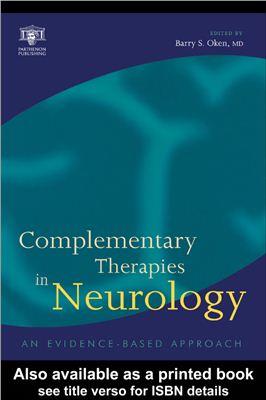The Parthenon Publishing Group
Inteational Publishers in Medicine, Science & Technology
A CRC Press Company, New York, 2005. – 534 p.
There is a significant use of complementary and alteative therapies throughout the world. Many of these therapies may offer benefits to people with neurological diseases. Some of these benefits are proven, some are not well studied, and some of these purported benefits have already been shown to be lacking. These complementary therapies may interact with conventional treatments, so it is critical for conventionally trained health-care providers to be knowledgeable about the complementary therapies their patients are using. Despite these facts, there is a lack of knowledge of complementary therapies by many conventionally trained physicians. For all these reasons, it seemed an appropriate time to provide a book focusing on complementary therapies for neurological disorders. This book is targeted to any health-care provider who sees people with neurological diseases. While there are other books in the general area and even one for neurological disorders, the scientific level of all the chapters, especially those sections organized by disease states or conditions, should be accessible to even the most scientifically stringent, conventionally trained physicians, including neurologists.
Inteational Publishers in Medicine, Science & Technology
A CRC Press Company, New York, 2005. – 534 p.
There is a significant use of complementary and alteative therapies throughout the world. Many of these therapies may offer benefits to people with neurological diseases. Some of these benefits are proven, some are not well studied, and some of these purported benefits have already been shown to be lacking. These complementary therapies may interact with conventional treatments, so it is critical for conventionally trained health-care providers to be knowledgeable about the complementary therapies their patients are using. Despite these facts, there is a lack of knowledge of complementary therapies by many conventionally trained physicians. For all these reasons, it seemed an appropriate time to provide a book focusing on complementary therapies for neurological disorders. This book is targeted to any health-care provider who sees people with neurological diseases. While there are other books in the general area and even one for neurological disorders, the scientific level of all the chapters, especially those sections organized by disease states or conditions, should be accessible to even the most scientifically stringent, conventionally trained physicians, including neurologists.

